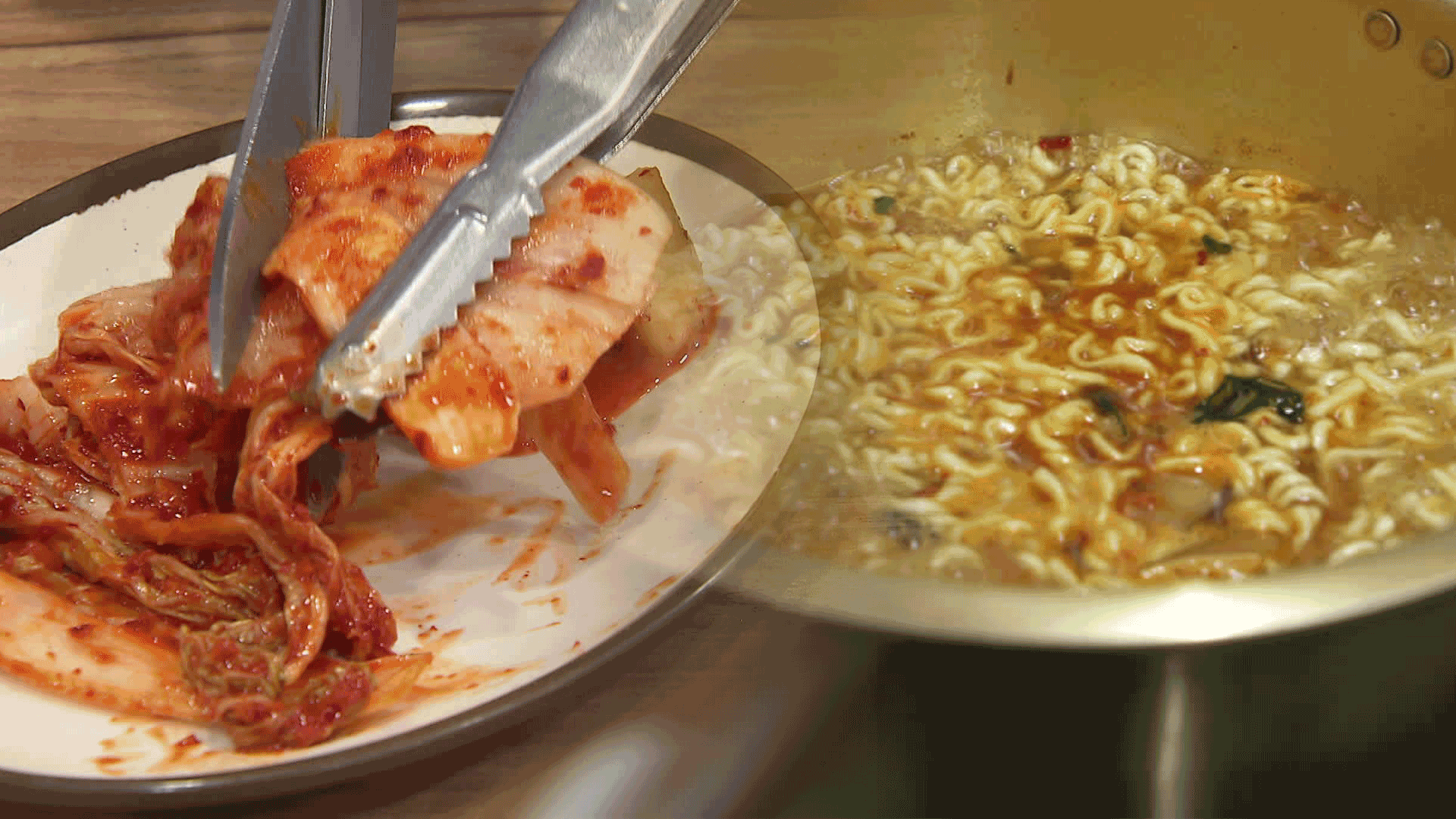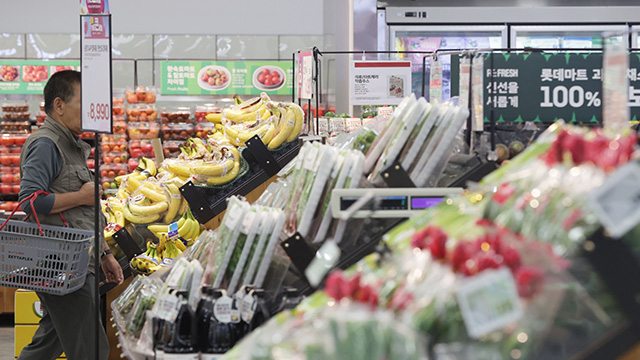[Anchor]
It has been revealed that the amount of sodium consumed by our citizens daily is significantly higher than the recommended amount by the World Health Organization.
Kimchi, soup, stews, and ramen, which are almost always present on the dining table, are cited as the main causes.
Reporter Kim Seong-soo has the story.
[Report]
Adding even more salt to an already savory bowl of sundae (blood sausage) soup.
Pairing it with spicy kimchi and salty side dishes.
People often enjoy salty foods without paying much attention to how much sodium they’re actually consuming.
[Kim Young-hyun/Goyang, Gyeonggi Province: "After I finish eating, I always go home and gulp down water, thinking it was pretty salty.”]
Excess sodium intake can lead to conditions such as high blood pressure and diabetes.
According to a five-year study conducted by the Ministry of Food and Drug Safety since 2019, the average daily sodium intake among Koreans is 3,136 mg.
That equates to 8 grams of salt—1.6 times higher than the World Health Organization's recommended daily limit.
The highest source of sodium intake was from instant noodles and dumplings, accounting for 15.3%, followed by kimchi and soups.
Across all age groups, ramen and napa cabbage kimchi were major contributors to sodium consumption.
Men consumed 1.4 times more sodium than women.
By age group, those in their 30s and 40s consumed the most, likely due to frequent dining out, which tends to involve high-sodium foods.
[Kim Han-sol / Mapo-gu, Seoul: "When I eat out, I definitely feel the food is more heavily seasoned. Salty and savory dishes tend to taste better, after all."]
To reduce sodium intake, it is advised to eat out less and consume food that is less spicy and heavily seasoned.
[Lee Soon-ho / Director, Nutrition Function Research Division, Ministry of Food and Drug Safety: "Use ingredients like kelp and anchovy powder for flavor, and blanch processed foods like ham and sausage in boiling water..."]
As seen in other countries, placing mandatory warning labels on high-sodium foods is also being considered as an effective way to reduce sodium intake.
KBS News, Kim Seong-soo.
It has been revealed that the amount of sodium consumed by our citizens daily is significantly higher than the recommended amount by the World Health Organization.
Kimchi, soup, stews, and ramen, which are almost always present on the dining table, are cited as the main causes.
Reporter Kim Seong-soo has the story.
[Report]
Adding even more salt to an already savory bowl of sundae (blood sausage) soup.
Pairing it with spicy kimchi and salty side dishes.
People often enjoy salty foods without paying much attention to how much sodium they’re actually consuming.
[Kim Young-hyun/Goyang, Gyeonggi Province: "After I finish eating, I always go home and gulp down water, thinking it was pretty salty.”]
Excess sodium intake can lead to conditions such as high blood pressure and diabetes.
According to a five-year study conducted by the Ministry of Food and Drug Safety since 2019, the average daily sodium intake among Koreans is 3,136 mg.
That equates to 8 grams of salt—1.6 times higher than the World Health Organization's recommended daily limit.
The highest source of sodium intake was from instant noodles and dumplings, accounting for 15.3%, followed by kimchi and soups.
Across all age groups, ramen and napa cabbage kimchi were major contributors to sodium consumption.
Men consumed 1.4 times more sodium than women.
By age group, those in their 30s and 40s consumed the most, likely due to frequent dining out, which tends to involve high-sodium foods.
[Kim Han-sol / Mapo-gu, Seoul: "When I eat out, I definitely feel the food is more heavily seasoned. Salty and savory dishes tend to taste better, after all."]
To reduce sodium intake, it is advised to eat out less and consume food that is less spicy and heavily seasoned.
[Lee Soon-ho / Director, Nutrition Function Research Division, Ministry of Food and Drug Safety: "Use ingredients like kelp and anchovy powder for flavor, and blanch processed foods like ham and sausage in boiling water..."]
As seen in other countries, placing mandatory warning labels on high-sodium foods is also being considered as an effective way to reduce sodium intake.
KBS News, Kim Seong-soo.
■ 제보하기
▷ 카카오톡 : 'KBS제보' 검색, 채널 추가
▷ 전화 : 02-781-1234, 4444
▷ 이메일 : kbs1234@kbs.co.kr
▷ 유튜브, 네이버, 카카오에서도 KBS뉴스를 구독해주세요!
- Sodium intake exceeds WHO limit
-
- 입력 2025-07-02 00:31:00

[Anchor]
It has been revealed that the amount of sodium consumed by our citizens daily is significantly higher than the recommended amount by the World Health Organization.
Kimchi, soup, stews, and ramen, which are almost always present on the dining table, are cited as the main causes.
Reporter Kim Seong-soo has the story.
[Report]
Adding even more salt to an already savory bowl of sundae (blood sausage) soup.
Pairing it with spicy kimchi and salty side dishes.
People often enjoy salty foods without paying much attention to how much sodium they’re actually consuming.
[Kim Young-hyun/Goyang, Gyeonggi Province: "After I finish eating, I always go home and gulp down water, thinking it was pretty salty.”]
Excess sodium intake can lead to conditions such as high blood pressure and diabetes.
According to a five-year study conducted by the Ministry of Food and Drug Safety since 2019, the average daily sodium intake among Koreans is 3,136 mg.
That equates to 8 grams of salt—1.6 times higher than the World Health Organization's recommended daily limit.
The highest source of sodium intake was from instant noodles and dumplings, accounting for 15.3%, followed by kimchi and soups.
Across all age groups, ramen and napa cabbage kimchi were major contributors to sodium consumption.
Men consumed 1.4 times more sodium than women.
By age group, those in their 30s and 40s consumed the most, likely due to frequent dining out, which tends to involve high-sodium foods.
[Kim Han-sol / Mapo-gu, Seoul: "When I eat out, I definitely feel the food is more heavily seasoned. Salty and savory dishes tend to taste better, after all."]
To reduce sodium intake, it is advised to eat out less and consume food that is less spicy and heavily seasoned.
[Lee Soon-ho / Director, Nutrition Function Research Division, Ministry of Food and Drug Safety: "Use ingredients like kelp and anchovy powder for flavor, and blanch processed foods like ham and sausage in boiling water..."]
As seen in other countries, placing mandatory warning labels on high-sodium foods is also being considered as an effective way to reduce sodium intake.
KBS News, Kim Seong-soo.
It has been revealed that the amount of sodium consumed by our citizens daily is significantly higher than the recommended amount by the World Health Organization.
Kimchi, soup, stews, and ramen, which are almost always present on the dining table, are cited as the main causes.
Reporter Kim Seong-soo has the story.
[Report]
Adding even more salt to an already savory bowl of sundae (blood sausage) soup.
Pairing it with spicy kimchi and salty side dishes.
People often enjoy salty foods without paying much attention to how much sodium they’re actually consuming.
[Kim Young-hyun/Goyang, Gyeonggi Province: "After I finish eating, I always go home and gulp down water, thinking it was pretty salty.”]
Excess sodium intake can lead to conditions such as high blood pressure and diabetes.
According to a five-year study conducted by the Ministry of Food and Drug Safety since 2019, the average daily sodium intake among Koreans is 3,136 mg.
That equates to 8 grams of salt—1.6 times higher than the World Health Organization's recommended daily limit.
The highest source of sodium intake was from instant noodles and dumplings, accounting for 15.3%, followed by kimchi and soups.
Across all age groups, ramen and napa cabbage kimchi were major contributors to sodium consumption.
Men consumed 1.4 times more sodium than women.
By age group, those in their 30s and 40s consumed the most, likely due to frequent dining out, which tends to involve high-sodium foods.
[Kim Han-sol / Mapo-gu, Seoul: "When I eat out, I definitely feel the food is more heavily seasoned. Salty and savory dishes tend to taste better, after all."]
To reduce sodium intake, it is advised to eat out less and consume food that is less spicy and heavily seasoned.
[Lee Soon-ho / Director, Nutrition Function Research Division, Ministry of Food and Drug Safety: "Use ingredients like kelp and anchovy powder for flavor, and blanch processed foods like ham and sausage in boiling water..."]
As seen in other countries, placing mandatory warning labels on high-sodium foods is also being considered as an effective way to reduce sodium intake.
KBS News, Kim Seong-soo.
-
-

김성수 기자 ssoo@kbs.co.kr
김성수 기자의 기사 모음
-
이 기사가 좋으셨다면
-
좋아요
0
-
응원해요
0
-
후속 원해요
0















이 기사에 대한 의견을 남겨주세요.